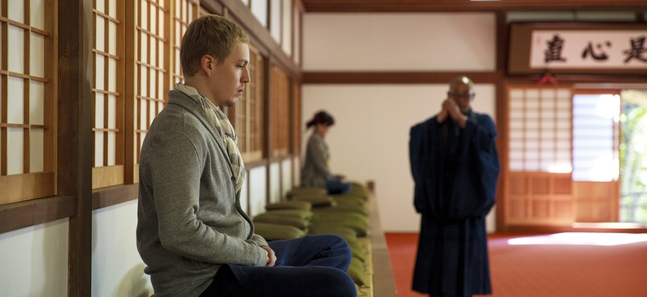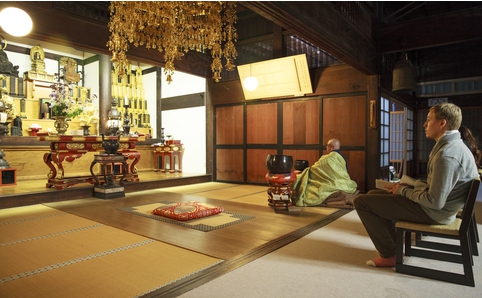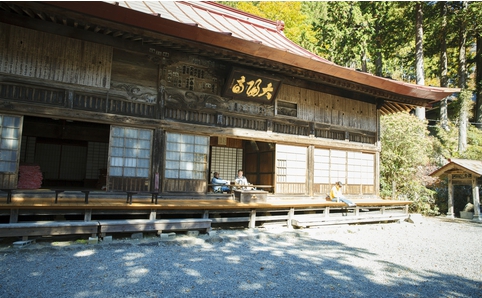Spend the night at a temple
Find out what it's like to be a monk

Posted: Tue Feb 24 2015
Are Tokyo’s suffocating crowds, near-ceaseless noise pollution and hectic atmosphere taking their toll on you? Feel like your nerves need a complete rest, if only for a couple of days? Unlikely as it may sound, there’s no need to travel great distances in order to find peace of mind – Taiyoji, a Zen temple deep in the mountains of Saitama’s Chichibu region, offers a retreat complete with first-hand insight into the daily life of a lone Buddhist monk.

Originally conceived as a service for visiting pilgrims, shukubo (temple lodging) is now open to anyone interested in taking a break from the daily grind. Our road to enlightenment started at Mitsumineguchi Station, the last stop on the wonderfully retro Chichibu Railway line, where Sotatsu Asami greeted us and drove us up the winding mountain roads to the temple. Impeccably friendly and courteous, Mr Asami is Taiyoji’s only resident monk and also runs the inn all by himself, yet consistently appears as if he’s got all the time in the world.
 Upon arrival, the first thing we noticed was the location: the temple is perched on a mountainside high above a river valley, providing an astounding view of the Mitsumine (‘three peaks’) mountains of Chichibu-Tama-Kai National Park. Once we were all settled in the sturdy main building, the ‘activities’ commenced with an introduction to sutra copying, which tested our patience and steadiness of hand, and also whetted our appetite just in time for the shojin ryori (Buddhist cuisine) dinner. After our tasty vegetarian meal, made mainly with ingredients sourced from local farmers, the good monk taught us more about Zen, its concept of ‘mu’ (‘without’ or ‘nothingness’) and how meditation can help us rid ourselves of everyday pressures. A stressed-out salaryman in his past life, Mr Asami sure knows what he’s talking about — and with his teachings in mind, we closed out the day with a soak in the outdoor bath.
Upon arrival, the first thing we noticed was the location: the temple is perched on a mountainside high above a river valley, providing an astounding view of the Mitsumine (‘three peaks’) mountains of Chichibu-Tama-Kai National Park. Once we were all settled in the sturdy main building, the ‘activities’ commenced with an introduction to sutra copying, which tested our patience and steadiness of hand, and also whetted our appetite just in time for the shojin ryori (Buddhist cuisine) dinner. After our tasty vegetarian meal, made mainly with ingredients sourced from local farmers, the good monk taught us more about Zen, its concept of ‘mu’ (‘without’ or ‘nothingness’) and how meditation can help us rid ourselves of everyday pressures. A stressed-out salaryman in his past life, Mr Asami sure knows what he’s talking about — and with his teachings in mind, we closed out the day with a soak in the outdoor bath.
Heading to bed early turned out to be an inspired move, as we were able to get up in time to breathe in the clear morning air and catch the sun rise above the nearby peaks. Next, it was finally time to try out zazen (‘seated meditation’, the core of Zen), practised in a purpose-built hall that boasts some of the best views on the premises. Listening to the detailed instructions, we were happy to learn that lapses in concentration wouldn’t be punished with a swift swing of the ‘encouragement stick’ (unless you like that sort of thing, in which case you can ask for it). It wasn’t until the mind-purifying but physically challenging session (who knew sitting in half-lotus for half an hour could be so hard?) that we noticed the perfect quiet. This truly is a majestically serene place, which explains why Taiyoji has been frequented by those seeking solitude and inner peace ever since its founding back in 1313.
 It had only been 20 hours or so, but heading back to Tokyo felt bittersweet. Although we were probably well-equipped to handle everyday pressures after all that mental strengthening, we couldn’t shake the thought that staying up in the mists, out of reach from phone calls and emails, sure felt like the more attractive alternative.
It had only been 20 hours or so, but heading back to Tokyo felt bittersweet. Although we were probably well-equipped to handle everyday pressures after all that mental strengthening, we couldn’t shake the thought that staying up in the mists, out of reach from phone calls and emails, sure felt like the more attractive alternative.
Essential info

Contact 459 Otaki, Chichibu, Saitama. www.taiyoji.com. Reservations can be made in English by phone on 04 9454 0296 or via the booking form.
Cost ¥9,000 per night, per person. Includes dinner and breakfast. Participation in all activities is voluntary (but highly recommended).
How to get there Take the Seibu Express from Ikebukuro to Seibu-Chichibu Station, then walk a few minutes to Ohanabatake Station and ride the Chichibu Railway to Mitsumineguchi Station. Pick-up service must be arranged when booking. Total journey time to the temple is approximately 2.5 hours.
Thee more shukubo to try
Komadori Sanso
Takigyo or ‘waterfall training’, practised by steely-minded ascetics for centuries, is said to both build character and be great for your circulation. To try it, head over to the Komadori lodge up on Mt Mitake, where the proprietors will teach you correct form, provide you with a loincloth and take you all the way up to the Ayahiro waterfall to get splashed. Rates vary by season, but start at around ¥10,000 per person for one night’s accommodation and the takigyo experience. 155 Mitakesan, Ome, Tokyo. 04 2878 8472. www.komadori.com
Muryokoin
Located a few hours south of Osaka, the World Heritage-designated Mt Koya is one of the most popular places for shukubo and is very convenient if you’re staying in the Kansai area. The site is home to more than 100 temples, including the historical Muryokoin, which offers both reasonably priced lodging and service in English. Rates from ¥6,480 per person for bed and breakfast. 611 Koyasan, Koya-cho, Ito-gun, Wakayama. 07 3656 2104. www.muryokoin.org/int
Oshi Ryokan
Built to provide shelter for pilgrims visiting the ancient Togakushi Shrine, Oshi Ryokan’s main building has stood for more than 250 years but now offers plenty of modern conveniences, including 24-hour jetbaths and TVs. When visiting, make sure to try the soba noodles, a renowned local speciality. Rates from ¥6,000 per person (plus tax) for bed and breakfast. 2332 Hokosha-Togakushi, Nagano. 02 6254 2007. www.oshiryokan.com/eng1.htm
This article originally appeared in issue 5 of Time Out Tokyo magazine.

Tweets
- About Us |
- Work for Time Out |
- Send us info |
- Advertising |
- Mobile edition |
- Terms & Conditions |
- Privacy policy |
- Contact Us
Copyright © 2014 Time Out Tokyo














Add your comment